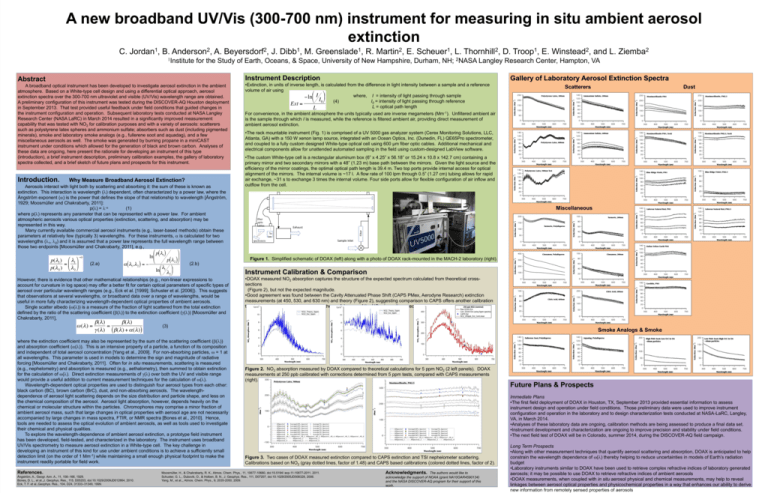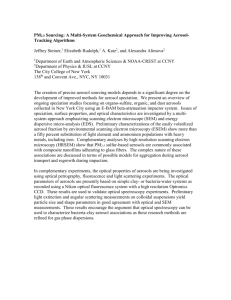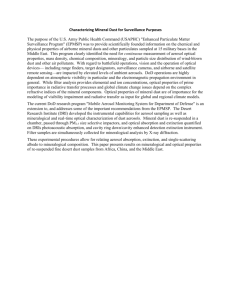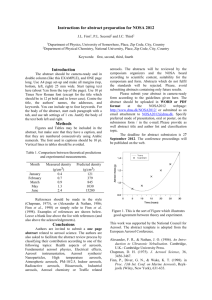Here is the Original File - University of New Hampshire
advertisement

A new broadband UV/Vis (300-700 nm) instrument for measuring in situ ambient aerosol extinction C. 1 Jordan , B. 2 Anderson , 1Institute A. 2 Beyersdorf , M. 1 Greenslade , R. 2 Martin , E. 1 Scheuer , L. 2 Thornhill , D. 1 Troop , E. 2 Winstead , and L. 2 Ziemba for the Study of Earth, Oceans, & Space, University of New Hampshire, Durham, NH; 2NASA Langley Research Center, Hampton, VA Instrument Description Abstract A broadband optical instrument has been developed to investigate aerosol extinction in the ambient atmosphere. Based on a White-type cell design and using a differential optical approach, aerosol extinction spectra over the 300-700 nm ultraviolet and visible (UV/Vis) wavelength range are obtained. A preliminary configuration of this instrument was tested during the DISCOVER-AQ Houston deployment in September 2013. That test provided useful feedback under field conditions that guided changes in the instrument configuration and operation. Subsequent laboratory tests conducted at NASA Langley Research Center (NASA LaRC) in March 2014 resulted in a significantly improved measurement capability that was tested with NO2 for calibration purposes and with a variety of aerosols: scatterers such as polystyrene latex spheres and ammonium sulfate; absorbers such as dust (including pigmented minerals), smoke and laboratory smoke analogs (e.g., fullerene soot and aquadag), and a few miscellaneous aerosols as well. The smoke was generated by burning propane in a miniCAST instrument under conditions which allowed for the generation of black and brown carbon. Analyses of these data are ongoing, here present the rationale for developing an instrument of this type (introduction), a brief instrument description, preliminary calibration examples, the gallery of laboratory spectra collected, and a brief sketch of future plans and prospects for this instrument. Introduction. J. 1 Dibb , Why Measure Broadband Aerosol Extinction? Aerosols interact with light both by scattering and absorbing it: the sum of these is known as extinction. This interaction is wavelength (l) dependent, often characterized by a power law, where the Ångström exponent (a) is the power that defines the slope of that relationship to wavelength [Ångström, 1929; Moosmüller and Chakrabarty, 2011]: p(l) = l-a (1) where p(l) represents any parameter that can be represented with a power law. For ambient atmospheric aerosols various optical properties (extinction, scattering, and absorption) may be represented in this way. Many currently available commercial aerosol instruments (e.g., laser-based methods) obtain these parameters at relatively few (typically 3) wavelengths. For these instruments, a is calculated for two wavelengths (l1, l2) and it is assumed that a power law represents the full wavelength range between those two endpoints [Moosmüller and Chakrabarty, 2011], e.g., Gallery of Laboratory Aerosol Extinction Spectra •Extinction, in units of inverse length, is calculated from the difference in light intensity between a sample and a reference volume of air using where, I = intensity of light passing through sample I0 = intensity of light passing through reference (4) L = optical path length Scatterers Dust For convenience, in the ambient atmosphere the units typically used are inverse megameters (Mm-1). Unfiltered ambient air is the sample through which I is measured, while the reference is filtered ambient air, providing direct measurement of ambient aerosol extinction. •The rack mountable instrument (Fig. 1) is comprised of a UV 5000 gas analyzer system (Cerex Monitoring Solutions, LLC, Atlanta, GA) with a 150 W xenon lamp source, integrated with an Ocean Optics, Inc. (Dunedin, FL) QE65Pro spectrometer, and coupled to a fully custom designed White-type optical cell using 600 µm fiber optic cables. Additional mechanical and electrical components allow for unattended automated sampling in the field using custom-designed LabView software. •The custom White-type cell is a rectangular aluminum box (6” x 4.25” x 56.18” or 15.24 x 10.8 x 142.7 cm) containing a primary mirror and two secondary mirrors with a 48” (1.23 m) base path between the mirrors. Given the light source and the efficiency of the mirror coatings, the optimal optical path length is 39.4 m. Two top ports provide internal access for optical alignment of the mirrors. The internal volume is ~17 l. A flow rate of 100 lpm through 0.5” (1.27 cm) tubing allows for rapid air exchange, ~31 s to exchange 3 times the internal volume. Four side ports allow for flexible configuration of air inflow and outflow from the cell. Miscellaneous Figure 1. Simplified schematic of DOAX (left) along with a photo of DOAX rack-mounted in the MACH-2 laboratory (right). (2.a) (2.b) Instrument Calibration & Comparison However, there is evidence that other mathematical relationships (e.g., non-linear expressions to account for curvature in log space) may offer a better fit for certain optical parameters of specific types of aerosol over particular wavelength ranges (e.g., Eck et al. [1999]; Schuster et al. [2006]). This suggests that observations at several wavelengths, or broadband data over a range of wavelengths, would be useful in more fully characterizing wavelength-dependent optical properties of ambient aerosols. Single scatter albedo (w(l)) is a measure of the fraction of light scattered from the total extinction defined by the ratio of the scattering coefficient (b(l)) to the extinction coefficient (g(l)) [Moosmüller and Chakrabarty, 2011], •DOAX measured NO2 absorption captures the structure of the expected spectrum calculated from theoretical crosssections (Figure 2), but not the expected magnitude. •Good agreement was found between the Cavity Attenuated Phase Shift (CAPS PMex, Aerodyne Research) extinction measurements (at 450, 530, and 630 nm) and theory (Figure 2), suggesting comparison to CAPS offers another calibration tool for wavelengths > 500 nm, beyond the useful range of the NO2 absorption spectrum, e.g., Figure 3. (3) where the extinction coefficient may also be represented by the sum of the scattering coefficient (b(l)) and absorption coefficient (a(l)). This is an intensive property of a particle, a function of its composition and independent of total aerosol concentration [Yang et al., 2009]. For non-absorbing particles, w = 1 at all wavelengths. This parameter is used in models to determine the sign and magnitude of radiative forcing [Moosmüller and Chakrabarty, 2011]. Often for in situ measurements, scattering is measured (e.g., nephelometry) and absorption is measured (e.g., aethalometry), then summed to obtain extinction for the calculation of w(l). Direct extinction measurements of g(l) over both the UV and visible range would provide a useful addition to current measurement techniques for the calculation of w(l). Wavelength-dependent optical properties are used to distinguish four aerosol types from each other: black carbon (BC), brown carbon (BrC), dust, and non-absorbing aerosols. The wavelengthdependence of aerosol light scattering depends on the size distribution and particle shape, and less on the chemical composition of the aerosol. Aerosol light absorption, however, depends heavily on the chemical or molecular structure within the particles. Chromophores may comprise a minor fraction of ambient aerosol mass, such that large changes in optical properties with aerosol age are not necessarily accompanied by large changes in mass spectra, FTIR, or NMR spectra [Bones et al., 2010]. Hence, tools are needed to assess the optical evolution of ambient aerosols, as well as tools used to investigate their chemical and physical qualities. To explore the wavelength-dependence of ambient aerosol extinction, a prototype field instrument has been developed, field-tested, and characterized in the laboratory. The instrument uses broadband UV/Vis spectrometry to measure aerosol extinction in a White-type cell. The key challenge in developing an instrument of this kind for use under ambient conditions is to achieve a sufficiently small detection limit (on the order of 1 Mm-1) while maintaining a small enough physical footprint to make the instrument readily portable for field work. References. Ångström, A., Geogr. Ann. A., 11, 156–166, 1929. Bones, D. L., et al.,J. Geophys. Res., 115, D05203, doi:10.1029/2009JD012864, 2010. Eck, T. F. et al.,Geophys. Res., 104, D24, 31333–31349, 1999. Smoke Analogs & Smoke Figure 2. NO2 absorption measured by DOAX compared to theoretical calculations for 5 ppm NO2 (2 left panels). DOAX measurements at 250 ppb calibrated with corrections determined from 5 ppm tests, compared with CAPS measurements (right). Future Plans & Prospects Immediate Plans •The first field deployment of DOAX in Houston, TX, September 2013 provided essential information to assess instrument design and operation under field conditions. Those preliminary data were used to improve instrument configuration and operation in the laboratory and to design characterization tests conducted at NASA-LaRC, Langley, VA, in March 2014. •Analyses of these laboratory data are ongoing, calibration methods are being assessed to produce a final data set. •Instrument development and characterization are ongoing to improve precision and stability under field conditions. •The next field test of DOAX will be in Colorado, summer 2014, during the DISCOVER-AQ field campaign. Figure 3. Two cases of DOAX measured extinction compared to CAPS extinction and TSI nephelometer scattering. Calibrations based on NO2 (gray dotted lines, factor of 1.48) and CAPS based calibrations (colored dotted lines, factor of 2). Moosmüller, H., & Chakrabarty, R. K., Atmos. Chem. Phys., 11, 10677-10680, doi:10.5194/ acp-11-10677-2011, 2011. Schuster, G. L., Dubovik, O., & Holben, B. N., J. Geophys. Res., 111, D07207, doi:10.1029/2005JD006328, 2006. Yang, M., et al.,, Atmos. Chem. Phys., 9, 2035-2050, 2009. Acknowledgments. The authors would like to acknowledge the support of NOAA (grant NA10OAR4590134) and the NASA DISCOVER-AQ program for their support of this work. Long Term Prospects •Along with other measurement techniques that quantify aerosol scattering and absorption, DOAX is anticipated to help constrain the wavelength dependence of w(l) thereby helping to reduce uncertainties in models of Earth’s radiation budget •Laboratory instruments similar to DOAX have been used to retrieve complex refractive indices of laboratory generated aerosols; it may be possible to use DOAX to retrieve refractive indices of ambient aerosols •DOAX measurements, when coupled with in situ aerosol physical and chemical measurements, may help to reveal linkages between aerosol optical properties and physicochemical properties in a way that enhances our ability to derive new information from remotely sensed properties of aerosols








